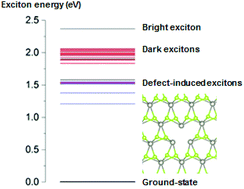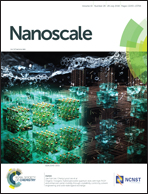Tunability in the optical response of defective monolayer WSe2 by computational analysis†
Abstract
In aiming to achieve red-shifted single-photon emitters that result from localized excitons in monolayer WSe2, we report in this work a theoretical investigation on the optical properties of nanostructures with vacancies and rotational defects. We find that for pristine monolayer WSe2, the complex excitonic manifold, namely, the energies of the bright and dark excitons and the exciton binding energy, agree well with the experimental data when using the GW (Green's function approximation with a screened Coulomb interaction W)-Bethe Salpeter Equation (GW-BSE) method, including spin–orbit coupling. The predicted second and third lowest dark excitons are close in energy and appear below the second bright exciton. Upon introduction of single or double Se vacancies, or a single W vacancy within monolayer WSe2, accurate computational results demonstrate emergence of deeper defect excitons in comparison to shallower values observed for edges, which are consistent with measured emissions upon Ar+ plasma treatment of WSe2 for longer periods of time. Furthermore, using corrected RPA (random phase approximation) calculations, we find that defect excitons red-shift significantly for large rotational defects that pattern the monolayer. Finally, interestingly, first-order Raman intensity calculations demonstrate that a comparison between pristine and defective monolayer WSe2 with a single vacancy can provide a fingerprint for defect characterization. Overall, our results will encourage experimental defect engineering to enable the development of red-shifted single-photon emitters, such as by inducing extended patterning of monolayer WSe2.



 Please wait while we load your content...
Please wait while we load your content...